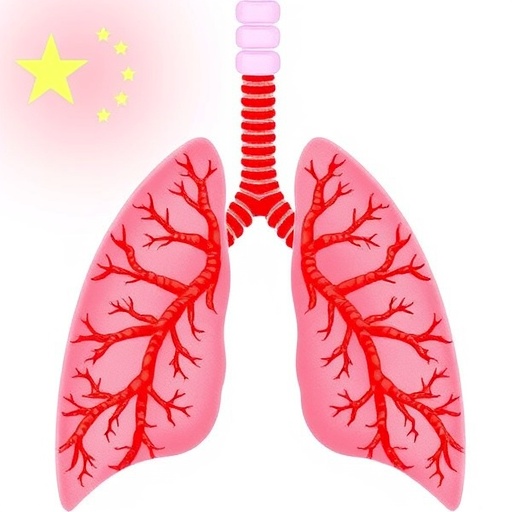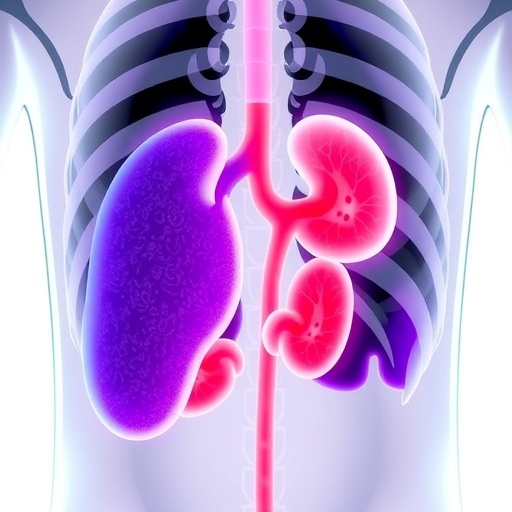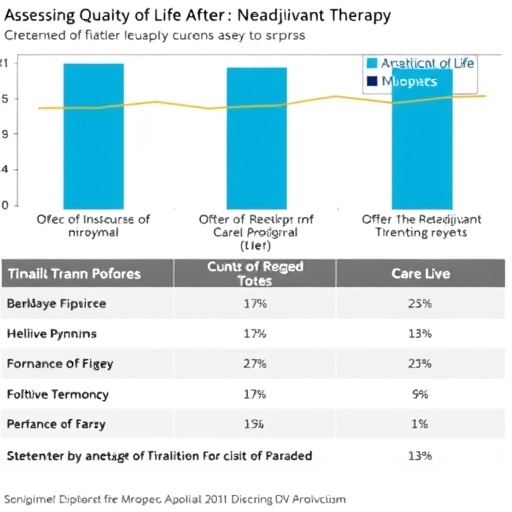
A groundbreaking new study sheds light on the evolving burden of tracheal, bronchus, and lung cancers in Fujian Province, China, revealing stark contrasts with global trends and underscoring urgent needs in healthcare quality improvement. Drawing on extensive data from both the Fujian Provincial Center for Disease Control and Prevention and the renowned Global Burden of Disease (GBD) database, researchers have meticulously tracked changes in incidence, mortality, and disability-adjusted life years (DALYs) over a span of nearly three decades. Their findings not only reflect shifting epidemiological patterns but also highlight the complex interplay of environmental and behavioral risk factors driving these deadly diseases.
The research, published in the latest volume of BMC Cancer, focuses specifically on age-standardized rates (ASRs) of tracheal, bronchus, and lung cancer, offering a nuanced exploration of how these rates have changed in Fujian from 1990 to 2019. Notably, the study employs rigorous statistical methodologies including joinpoint regression and age-period-cohort models, allowing for precise estimation of temporal trends. These advanced analytic frameworks provide insights into how cancer burdens fluctuate over time across different age groups and birth cohorts, affording a comprehensive temporal landscape of disease dynamics.
In 2019, the ASRs of incidence, mortality, and DALYs in Fujian Province were alarmingly high—39.08, 35.29, and 778.39 per 100,000 population, respectively—reflecting a substantial public health challenge. The study reports an average annual percent increase in incidence of 1.08%, mortality rising at 0.65%, while the rise in DALYs was subtler at 0.18%. While these figures may appear incremental, their cumulative impact over nearly three decades signals a looming epidemic. This steady upward trend contrasts with certain global regions where aggressive tobacco control and pollution reduction measures have stabilized or even reduced similar cancer burdens.
.adsslot_6g9Mfw8Cen{width:728px !important;height:90px !important;}
@media(max-width:1199px){ .adsslot_6g9Mfw8Cen{width:468px !important;height:60px !important;}
}
@media(max-width:767px){ .adsslot_6g9Mfw8Cen{width:320px !important;height:50px !important;}
}
ADVERTISEMENT
Gender disparities remain stark in this regional analysis. Males in Fujian exhibit tracheal, bronchus, and lung cancer burdens exceeding threefold those observed in females, consistent with broader epidemiological patterns linked to differential smoking rates and occupational exposures. Intriguingly, however, the female population demonstrates an upward trajectory in cancer incidence and burden from 2015 to 2019, a worrisome reversal that may reflect changing social behaviors, increased exposure to risk factors such as secondhand smoke, or environmental pollutants. This trend highlights the necessity for gender-sensitive public health interventions.
Perhaps most striking is the age-related explosion in cancer burden, with a sharp rise observed after the age of 50. This pattern aligns with the biological latency of carcinogenesis in respiratory tissues and underscores the critical window for prevention, early detection, and clinical management. The study’s use of sophisticated models elucidates how aging interacts with exposure history and cohort effects to shape cancer risks, providing invaluable direction for targeting screening programs effectively.
On the environmental front, the research draws attention to the shifting landscape of attributable risk factors. Ambient particulate matter pollution has increasingly contributed to age-standardized DALY rates, overtaking household solid fuel use, which paradoxically showed a declining impact over the years studied. This evolution mirrors broader industrial and urban development trends in China, where outdoor air quality remains a persistent concern despite efforts to control indoor pollution. The findings underscore the urgent need to integrate environmental health policies with cancer prevention strategies.
Smoking and exposure to secondhand smoke continue to dominate as primary risk factors, corroborating decades of evidence linking tobacco to respiratory cancers. However, the study expands this narrative by quantifying attributable burdens in a granular, time-sensitive manner, painting a dynamic picture of how public health efforts and lifestyle shifts influence disease trajectories. It also implicitly cautions against complacency in tobacco control, given the sustained rise in incidence rates despite existing interventions.
Crucially, this investigation pioneers in assessing the quality of care through the development of a quality-of-care index (QCI), leveraging principal component analysis to distill multifaceted healthcare indicators into a coherent metric. The QCI exhibited an age-related increase, suggesting that older patients potentially receive more complex, perhaps intensive care; nonetheless, the overall temporal trend from 1990 to 2019 reveals a decline in care quality. This paradox raises critical questions about healthcare system capacity, accessibility, and resource allocation amid growing cancer burdens.
Such a decline in care quality amidst escalating disease incidence poses profound implications for health policy and clinical practice in Fujian. It signals potential systemic bottlenecks or inequities that hamper effective cancer management, including diagnosis, treatment, and palliative services. These insights advocate for renewed focus on healthcare infrastructure, professional training, and patient-centered models to enhance outcomes in lung and airway cancers.
The study’s findings resonate beyond regional boundaries, offering comparative perspectives that situate Fujian within global cancer trends. While some countries are witnessing stabilization or reductions in tracheal, bronchus, and lung cancer burdens due to proactive public health policies, Fujian’s experience exemplifies how rapid development, environmental transitions, and demographic shifts can modulate disease patterns differently. This contrast invites broader discussions on tailored interventions that account for unique sociocultural and environmental contexts.
Moreover, the methodological rigor and comprehensive data integration showcased in this research set a new standard for cancer epidemiology. The fusion of local public health data with global databases enriches the analytic depth, enabling more precise and actionable insights. By harnessing age-period-cohort frameworks and advanced statistical tools, the study transcends simple descriptive statistics, offering a dynamic narrative of cancer burdens’ evolution.
Importantly, the researchers call for multi-pronged approaches to mitigate rising cancer trends in Fujian. Combating smoking remains foundational, yet the increasing role of ambient particulate matter pollution necessitates environmental regulatory reforms and community-level awareness. Simultaneously, addressing gender-specific vulnerabilities, especially the rising female cancer burden, requires culturally sensitive education and preventive measures.
The revelation that care quality has not kept pace with increasing cancer incidence is a stark reminder that healthcare systems must evolve responsively. Efforts to enhance early detection through screening programs, optimize treatment protocols, and ensure equitable access to new therapeutics are imperative. The study implicitly advocates for policymaker engagement, investing adequately in oncology services and research infrastructure.
In conclusion, this impactful research underscores the significant and growing burden of tracheal, bronchus, and lung cancers in Fujian Province, China. It unravels the intricate web of epidemiological trends shaped by aging, environmental exposures, and lifestyle factors. Concurrently, it exposes gaps in care quality that may exacerbate morbidity and mortality. The findings represent a clarion call for intensified public health initiatives, environmental interventions, and healthcare system reforms to curtail the rising tide of these cancers locally and potentially elsewhere.
As this landmark study circulates within scientific and clinical communities, it paves the way for future research investigating mechanisms behind gender disparities, pollution-linked carcinogenesis, and strategies to enhance healthcare delivery models. Ultimately, it delivers an urgent message: the fight against tracheal, bronchus, and lung cancer demands holistic, data-driven, and equity-focused responses to transform outcomes for populations at risk.
Subject of Research: Temporal trends of tracheal, bronchus, and lung cancer burden, attributable risk factors, and quality of care assessment in Fujian Province, China, compared with global trends.
Article Title: Contrasting tracheal, bronchus, and lung cancer burdens and care quality: a comparative analysis of China and global trends.
Article References: Lin, X., Liu, S., Ding, Y. et al. Contrasting tracheal, bronchus, and lung cancer burdens and care quality: a comparative analysis of China and global trends. BMC Cancer 25, 1298 (2025). https://doi.org/10.1186/s12885-025-14645-4
Image Credits: Scienmag.com
DOI: https://doi.org/10.1186/s12885-025-14645-4
Tags: age-standardized rates lung cancerbehavioral risk factors cancer Fujianbronchus cancer epidemiology Chinadisability-adjusted life years lung cancerenvironmental risk factors lung cancerhealthcare quality improvement Chinaincidence rates of lung cancerlongitudinal study cancer epidemiologylung cancer global comparisonmortality trends tracheal bronchus lung cancerstatistical analysis cancer trendstracheal cancer trends in Fujian





